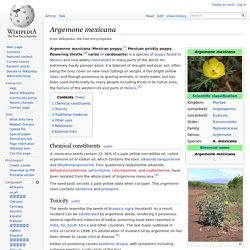

Opium poppy. Papaver somniferum, the Opium poppy, is the species of plant from which opium and poppy seeds are derived. Opium is the source of many narcotics, including morphine (and its derivative heroin), thebaine, codeine, papaverine, and noscapine. The Latin botanical name means the "sleep-bringing poppy", referring to the sedative properties of some of these opiates. The poppy is the only species of Papaveraceae that is an agricultural crop grown on a large scale. Other species, Papaver rhoeas and Papaver argemone, are important agricultural weeds, and may be mistaken for the crop. Argemone mexicana. Chemical constituents[edit] A. mexicana seeds contain 22–36% of a pale yellow non-edible oil, called argemone oil or katkar oil, which contains the toxic alkaloids sanguinarine and dihydrosanguinarine.

Four quaternary isoquinoline alkaloids, dehydrocorydalmine, jatrorrhizine, columbamine, and oxyberberine, have been isolated from the whole plant of Argemone mexicana.[4] Glaucium flavum. Glaucium flavum (yellow hornpoppy or yellow horned poppy) is a summer flowering plant in the Papaveraceae family, which is native to Northern Africa, Macronesia, temperate zones in Western Asia and the Caucasus, as well as Europe. Habitat: the plant grows on the seashore and is never found inland. All parts of the plant, including the seeds, are toxic and can produce a range of symptoms up to and including respiratory failure resulting in death FDA poisonous plants database.[1] It is a noxious weed in some areas of North America, where it is an introduced species. The thick, leathery deeply segmented, wavy, bluish-grey leaves are coated in a layer of water retaining wax. The sepal, petals and stamen have a similar structure and form to the Red Poppy (Papaver rhoeas) except the sepals are not hairy.